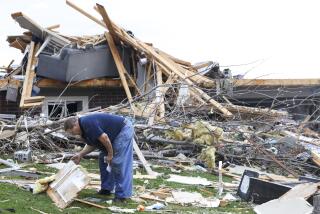A tour of destruction and hope
- Share via
OAKPORT TOWNSHIP, MINN. — Here among sugar beet fields and roadside signs advertising buffalo meat, the Red River has carved a path of destruction.
Across the river in North Dakota, Fargo, a city of 90,000, is bracing for a potentially devastating flood. But in Oakport Township -- population 1,600 -- icy runoff has submerged dikes and smashed windows. The river banged against doors and frothed off streets, stranding residents who refused to flee. The tops of mailboxes and cars poke from floodwater like buoys.
Kevin Campbell, Clay County commissioner, was aghast as he toured the neighborhood Saturday.
“It’s more water than I ever imagined,” he said, his eyes weary.
Campbell had evacuated his home here Friday, when forecasters were predicting the river might crest at a previously unthinkable 43 feet. Campbell, 55, slept in the employee lounge at the county courthouse, on a black imitation leather sofa.
“I thought it wouldn’t be good to stay here when I told everyone else to leave,” he said.
On Saturday, as Campbell made his rounds, the National Weather Service revised its estimates and said the river should stay below 41 feet and slowly recede.
The news was welcomed in Fargo, the nearby Minnesota town of Moorhead and rural areas such as Oakport Township, where residents have been rescued by canoes and swamp boats.
Their joy was muted, however. The river is expected to remain swollen for days, pushing against barriers made of earth, sandbags and, in Campbell’s neighborhood, hay bales. Thousands of National Guard troops and sleepless residents continued patrolling levees up and down Minnesota and North Dakota.
The danger prompted President Obama to devote his weekly address to the flooding, saying that the volunteer efforts were inspirational and that federal officials would provide any help needed. There has been some property damage in Fargo, but in Oakport Township and Moorhead, it was clear some houses would be lost.
And Campbell had no time to rest.
He drove his muddy red pickup -- stocked with bottled water, a walkie-talkie, a legal pad and ibuprofen -- to a township neighborhood called Brentwood Acres and his butter-colored, red-trimmed split-level home.
For a time, he and his wife, Kristy, each owned houses on opposite sides of the river. They decided where to settle in the 1980s by putting both houses on the market. His, in Fargo, sold first.
Last week, with his wife safe in a hotel in Detroit Lakes, Minn., Campbell hoped to wait out the flood here. Then he talked to the Sheriff’s Department. “They said to me, ‘Kevin, people first. Get them out.’ ”
All but 40 or so residents fled, some angry that anyone told them to run. Campbell shoved into a suitcase a few T-shirts and a burgundy button-down for commission meetings. He bought a toothbrush and a deodorant at Wal-Mart. When he awoke at the courthouse Saturday, he was determined to go home.
The road from Moorhead was lined with the cars of residents whose streets had flooded. Brentwood Acres was ghostly. Camouflage military vehicles veered around stacks of pallets and hay bales. Only a handmade lawn sign offered food and warmth.
Campbell checked his backyard first. A makeshift barrier had halted about 2 feet of water. He ducked into the house. His family had stripped the downstairs of possessions, and his cream carpet was dry. Upstairs, his family had stored a Goodwill’s worth of clothes, a 42-inch flat-screen TV and his 3-year-old granddaughter’s socks and toys.
He smiled, but briefly. A neighbor, Randy Berggren, had told him that others’ basements were steeped in sewage. Berggren also was reluctant to take comfort in the revised river forecast.
“If the levee broke right now, we’d be done,” he told Campbell. “It would overtake us.”
Campbell left Brentwood Acres with Spc. Raymond Pizarro, who pushed through more devastated streets in a 5-ton military vehicle. He pointed out a house that had caught fire and burned down before authorities could reach it. All that remained was a circle of sandbags and a chimney.
Another group of National Guard troops scooped up a woman who was evacuating in a green canoe. There was no running water at her house, which had escaped flooding. Pizarro said her husband had decided to stay behind.
A number of other folks had refused to evacuate: the woman who sat on her porch, watching her sump pump and the Christmas bulbs dangling on leafless trees; the man who checked his sandbags, spotted Pizarro and gave him a thumbs up.
Campbell chatted with Mike Larson, who wore earflaps and desert camouflage pants, wielded a shovel and never appeared to shiver in knee-high water that was kept away from his house by a barrier of sandbags. “That’s everything I got,” he said, pointing to his home. “I’ve got to protect it.”
Campbell returned to his truck and headed back to Moorhead. The sun had started to wane. He had to attend yet another flood briefing and was starting to get the days mixed up.
He arrived at the courthouse and stepped over a hastily made flood barrier. He shuffled back to work.
--
Times staff writer Kim Murphy in Seattle contributed to this report.
--
latimes.com/flooding
More photos of the Midwest flooding are available online.
More to Read
Sign up for Essential California
The most important California stories and recommendations in your inbox every morning.
You may occasionally receive promotional content from the Los Angeles Times.













